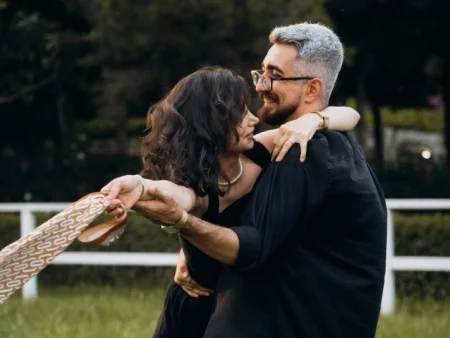The gentle intertwining of fingers, a subtle spark of chemistry – holding hands on a first date transcends a simple interaction. It’s an intricate dance of emotions, a silent language conveying mutual attraction and budding intimacy. As you approach this pivotal moment, excitement and nerves might flutter within. The warmth of another’s palm ignites a connection, offering a glimpse into potential romantic closeness.
This form of touch bridges two individuals, creating shared vulnerability. It’s an invitation to explore deeper feelings, a tender expression of affection that fosters comfort. Navigating this delicate interaction requires careful timing and mutual consent, ensuring this intimate gesture enhances your blossoming bond.
The Significance of Holding Hands
The act of holding hands transcends mere physical contact, serving as a powerful form of non-verbal communication that speaks volumes about budding relationships. This seemingly simple gesture carries profound significance, offering a window into the emotional landscape between two individuals. As hands intertwine, a cascade of psychological effects unfolds, fostering a sense of trust and intimacy that words alone cannot convey.
Consider the multifaceted benefits of this tender exchange:
- Builds an unspoken bond, creating a shared experience of vulnerability
- Releases oxytocin, promoting feelings of attachment and reducing stress
- Serves as a subtle yet clear expression of interest and attraction
- Enhances emotional connection through the power of touch
- Provides comfort and reassurance in moments of tension or uncertainty
- Synchronizes heart rates, creating a physiological link
- Boosts confidence and self-esteem in social situations
The initiation of hand-holding often marks a pivotal moment, signaling a desire for deeper intimacy. It’s an opportunity to gauge compatibility and mutual interest without the pressure of more overt displays of affection. As partners clasp hands, they may experience a surge of anticipation, curiosity, or even hesitation, each emotion offering valuable insights into the potential for future romantic development.
While some may dismiss hand-holding as a small gesture, its impact on relationship dynamics can be significant. It can foster a sense of security and even synchronize heart rates, creating a physiological connection that mirrors the emotional one. Whether walking through a park or sitting side by side, this simple act of tenderness can transform an ordinary moment into a memorable embrace of shared affection, making it a big deal in the early stages of dating.
Timing: When Is the Right Moment?
Initiating physical contact on a first date requires a delicate balance of intuition, observation, and respect. As you navigate the early stages of romantic interaction, consider various factors that influence the right moment for this intimate gesture.
The overall atmosphere plays a crucial role. A relaxed environment often provides a natural setting for closer proximity. Pay attention to your date’s body language and emotional cues. Are they leaning towards you? Do they seem at ease? These subtle signs can indicate receptiveness.
The level of rapport you’ve established is equally important. Engaging conversations and shared laughter create a foundation for increasing intimacy. As you walk side by side or sit closely, you may notice a gradual decrease in personal space, signaling growing comfort.
Every person has their own pace and boundaries. Respect these and proceed with sensitivity. Reading social cues accurately is a skill that develops with time and experience.
Consider the context of your date. A romantic stroll through a park or a cozy coffee shop might be more conducive than a formal dinner or a crowded event. Let the moment unfold naturally rather than forcing it.
Pay attention to your date’s gaze. Extended eye contact often indicates a desire for closer connection. If you find yourselves sharing lingering looks, it might be an opportune moment to bridge the gap.
Ultimately, the right moment is when both parties feel comfortable and there’s a mutual sense of attraction. It’s not about making a grand gesture, but rather a subtle acknowledgment of growing intimacy. It’s perfectly acceptable to verbally check in if you’re unsure about their readiness.
Timing this gesture correctly can set the tone for future interactions. It requires emotional intelligence and the ability to work with the natural flow of your date. Trust your instincts, but always prioritize mutual comfort and consent.
The Physical Aspect: How to Hold Hands Comfortably
Mastering the art of hand-holding requires finesse and sensitivity. The key lies in finding a position that feels natural and comfortable for both parties. A popular technique is the interlocked fingers approach, where palms meet and digits intertwine, creating a sense of unity. This style allows for gentle squeezes, conveying emotional support without words.
For a more relaxed grip, try the palm-to-palm method. Here, hands rest against each other, fingers aligned but not interlaced. This technique offers flexibility and ease, perfect for casual strolls or sitting side by side. It’s less intense than full interlocking, making it ideal for those still navigating the early stages of romance.
The thumb caress adds a layer of intimacy to any style. Gently rubbing your thumb over your partner’s hand or wrist can express affection and comfort. However, be mindful of your date’s reactions to ensure they’re receptive to this added touch.
For those seeking a compromise between intimacy and casualness, the fingertip hold offers a delicate solution. This involves loosely holding onto your date’s fingertips or hooking your index fingers together. It’s a subtle way to maintain physical connection without fully committing to a more encompassing grip.
Remember, comfort is paramount. If your palms tend to sweat, a looser hold might be preferable. Positioning is also crucial – aim for a natural angle that doesn’t strain either person’s wrist or arm. As you walk, allow your joined hands to swing gently between you, creating a harmonious rhythm.
Ultimately, the most comfortable hand-holding technique is one that evolves organically. Start with light touches and progress gradually, always attuned to your partner’s cues. With practice and mutual understanding, you’ll find a style that feels uniquely yours, transforming a simple gesture into a profound expression of budding affection.
To make the experience more enjoyable, focus on being present in the moment. Relax your grip and breathe naturally to alleviate any nervousness. Remember that hand-holding is a shared experience, so be receptive to your partner’s preferences as well. By approaching this intimate gesture with mindfulness and respect, you can create a meaningful connection that sets the tone for future interactions.
Reading Your Date’s Reactions
| Positive Body Language Cues | Negative Body Language Cues |
|---|---|
| Leaning towards you | Crossing arms or creating barriers |
| Mirroring your movements | Turning body away |
| Prolonged eye contact | Avoiding eye contact |
| Smiling and laughing often | Frowning or looking uncomfortable |
| Brushing against you “accidentally” | Increasing physical distance |
| Open posture with relaxed shoulders | Tense posture or fidgeting |
| Facing you directly | Angling body away or towards exits |
Deciphering your date’s reactions demands astute observation and emotional intelligence. Positive cues often signal openness to closeness. When your date leans in, their body language suggests interest and comfort. Mirroring, where they unconsciously match your gestures, indicates rapport. Frequent smiles and laughter foster a warm atmosphere conducive to intimacy.
Conversely, negative signals warrant caution. If your date crosses their arms or turns away, they may feel uncomfortable or unready for physical contact. Avoiding eye contact or increasing distance can indicate discomfort or disinterest. It’s crucial to respect these boundaries and refrain from initiating contact if these signs are present.
Remember, body language is nuanced and context-dependent. A single gesture doesn’t paint the full picture. Look for clusters of positive or negative signals to gauge your date’s comfort level. If you notice mixed signals, prioritize verbal communication to clarify intentions and ensure mutual comfort before initiating any physical contact.
Developing proficiency in reading these subtle cues takes practice and patience. By honing this skill, you’ll navigate the delicate early stages of dating with greater confidence and sensitivity, fostering a respectful and enjoyable experience for both parties involved.
Building Up to Hand-Holding
Cultivating a connection that naturally leads to hand-holding requires finesse and patience. Consider these steps to create opportunities for physical contact:
- Gradually decrease the space between you, subtly adjusting proximity
- Use brief, light touches on the arm during conversation to gauge comfort
- Create shared experiences that encourage closeness, like menu perusal
- Offer gentle assistance, such as helping with a coat
- Mirror body language to subtly align with your date
- Engage in activities that naturally bring you closer, like side-by-side walks
- Share laughter or exciting moments to foster connection
- Position yourself with hands within easy reach
- Use open body language to signal receptiveness
- Share something personal to create intimacy
As you progress, remain attuned to your date’s reactions. Positive responses, like reciprocated touches or leaning in, indicate readiness for more intimate gestures. The goal is to create a comfortable, natural progression that respects boundaries.
Timing is crucial in this delicate dance. Allow moments to develop organically. Rushing can create awkwardness, while patience builds anticipation. When the moment feels right, a gentle brush of your hand against theirs can serve as a silent invitation.
Maintain genuine interest in your conversation and shared experiences. Natural moments of physical connection often arise when both parties are fully present and engaged, rather than fixated on the prospect of hand-holding.
By following these steps and remaining attentive to your date’s cues, you create an emotional atmosphere conducive to a natural, mutual desire for connection. This approach ensures that when hands intertwine, it feels like a natural culmination of your growing bond.
What If They’re Not Ready?
Encountering hesitation or rejection when attempting to hold hands on a first date can be disheartening, but it’s essential to approach the situation with grace and understanding. If your date pulls away or seems uncomfortable, respect their boundaries immediately. This emotional intelligence demonstrates maturity and consideration for their feelings.
Take a step back and reassess the situation. Perhaps the timing wasn’t quite right, or your date needs more time to feel comfortable with physical contact. Remember, everyone’s pace in relationships is individual. Instead of dwelling on the rejection, refocus on building a genuine connection through conversation and shared experiences.
Respect in dating is like a dance. Sometimes you lead, sometimes you follow, but always move in harmony with your partner’s rhythm. This delicate balance requires patience, empathy, and a willingness to adapt to your partner’s comfort level.
Maintaining confidence is crucial, even in the face of rejection. Remind yourself that this single moment doesn’t define your worth or the potential of the relationship. Instead, view it as valuable feedback about your date’s comfort level and preferences.
If you’re unsure about your date’s readiness for physical contact, consider open communication. A simple, “Is it okay if I hold your hand?” can prevent misunderstandings and demonstrate respect for their boundaries. This approach allows your date to express their comfort level explicitly, fostering trust and mutual understanding.
Ultimately, a successful first date isn’t measured by physical milestones but by the quality of connection you’ve built. Focus on creating a positive, enjoyable experience for both parties, and let physical intimacy develop naturally as your relationship progresses. Remember, building a strong foundation of trust and respect will pave the way for deeper connections in the future.
Cultural Considerations
Cultural attitudes towards hand-holding on a first date vary significantly across the globe, reflecting diverse social norms and traditions. In many Western cultures, this gesture is often seen as a mild form of intimacy, generally acceptable early in dating. However, in more conservative societies, such as parts of the Middle East or South Asia, public displays of affection, including hand-holding, may be considered inappropriate or even taboo.
In Japan, for instance, public hand-holding among couples is becoming more common, especially among younger generations, but it’s still not as widespread as in Western countries. This reflects a gradual shift in social norms while maintaining respect for traditional values of public discretion.
Latin American cultures often embrace physical affection more openly, viewing hand-holding as a natural expression of interest and affection, even in early dating stages. Conversely, in some African cultures, hand-holding may carry different connotations depending on gender dynamics and local customs.
It’s crucial to consider individual preferences alongside cultural backgrounds. Even within cultures where hand-holding is common, personal comfort levels vary. Some may view it as a significant step in relationship progression, while others see it as a casual gesture.
In multicultural societies, navigating these differences requires sensitivity and open communication. Being aware of cultural nuances can prevent misunderstandings and foster mutual respect. It’s always wise to approach physical contact with consideration for your date’s background and personal boundaries.
Ultimately, the key lies in emotional intelligence and respectful communication. By being attentive to both verbal and non-verbal cues, you can navigate cultural differences gracefully, ensuring a comfortable experience for both parties as you explore the potential for connection.
Understanding these cultural variations enriches our perspective on dating norms globally. It reminds us that what may seem natural in one context could be perceived differently elsewhere. This awareness fosters empathy and adaptability, essential qualities in today’s interconnected world. As we navigate the delicate dance of first dates across cultures, remembering to approach each interaction with an open mind and respect for diverse traditions can lead to more meaningful and authentic connections.
After the First Hand-Hold: What Comes Next?
Successfully holding hands on a first date can pave the way for deeper connections. As your relationship progresses, consider these potential next steps:
- Explore shared interests through activities that foster closeness, such as cooking classes or nature walks
- Engage in meaningful conversations to deepen emotional intimacy, discussing hopes, dreams, and values
- Gradually increase physical affection through subtle gestures like a gentle touch on the arm or shoulder
- Plan future dates that align with both partners’ comfort levels, balancing adventure and relaxation
- Practice active listening to strengthen your bond, showing genuine interest in your partner’s thoughts
- Express appreciation for each other’s company and unique qualities, fostering a positive atmosphere
- Establish open communication about relationship expectations and boundaries
- Introduce playful elements to keep the connection light and fun, like surprise mini-adventures
- Share personal stories to build trust and understanding, revealing vulnerabilities gradually
- Explore each other’s love languages for more meaningful interactions, tailoring expressions of affection
Remember, every relationship unfolds at its own pace. Focus on nurturing genuine connection rather than rushing physical milestones. Be attentive to your partner’s cues and respect their boundaries. As comfort grows, you may naturally progress to more intimate gestures like hugging or kissing.
Cultivate patience and enjoy the journey of getting to know each other. This period of discovery can be exciting and rewarding in itself. By building a strong foundation based on mutual respect and understanding, you create the potential for a lasting and fulfilling relationship. Embrace the uniqueness of your connection, allowing it to bloom organically without pressure or comparison to others.
Conclusion: Embracing the Journey of Physical Connection
As we conclude our exploration of hand-holding on first dates, remember this simple gesture can powerfully catalyze connection. Approach it with sensitivity, respecting boundaries and cultural nuances. Pay attention to non-verbal cues and create organic moments for closeness. When timing feels right, a gentle touch speaks volumes.
Embrace building intimacy at your own pace. Hand-holding is one step in fostering a meaningful bond. Focus on genuine connection, open communication, and mutual respect. By approaching physical affection mindfully, you lay the foundation for a potentially deep and fulfilling emotional bond.
Common Questions About Holding Hands on a First Date
How can I tell if my date wants to hold hands?
Observe your date's body language closely. Leaning in, frequent eye contact, and decreased personal space often signal openness to touch. Notice subtle cues like mirroring movements or initiating light contact. If they position their hand near yours, it may indicate readiness. Always respect their emotional boundaries and comfort level.
What if my hands get sweaty when holding hands?
Sweaty palms during hand-holding are common and natural. To manage this, discreetly wipe your hands beforehand or carry a small handkerchief. Focus on the emotional aspect rather than physical discomfort. Remember, slight moisture can actually enhance grip and intimacy. If concerned, communicate openly with your date about your nervousness. Breathe deeply to calm yourself.
Should I ask before holding hands or just go for it?
Asking before holding hands demonstrates respect for boundaries and ensures mutual comfort. However, reading non-verbal cues can also guide actions. If you sense openness through body language and shared moments, gently initiating contact may feel natural. Ultimately, clear communication fosters trust, so choose the approach aligning with the emotional connection built.
Can holding hands on a first date lead to a kiss?
Hand-holding can potentially lead to a kiss on a first date, but it's not a guaranteed progression. The transition depends on unique chemistry, comfort levels, and emotional connection. While it may create intimacy, respecting boundaries and reading subtle cues is crucial. Each couple's journey is unique, so proceed thoughtfully, prioritizing mutual comfort and clear communication.

Jeffrey Young is an American psychologist renowned for developing schema therapy. He founded the Schema Therapy Institute and is a leader in the field of cognitive behavioral therapy. Young has authored several influential books, including Schema Therapy for professionals and Reinventing Your Life for the general public.







